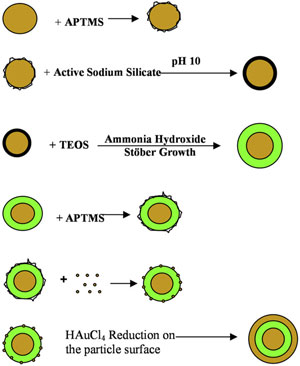| Posted: Nov 10, 2006 | |
Reducing the size of multi-layer nanoshells enables new sensing applications |
|
| (Nanowerk Spotlight) Nanoshells are a novel class of optically tunable nanoparticles that consist of alternating dielectric and metal layers. They have been shown to have tunable absorption frequencies that are dependent on the ratio of their inner and outer radii. Therefore nanoshells can potentially be used as contrast agents for multi-label molecular imaging, provided that the shell thicknesses are tuned to specific ratios. When used as contrast agents, nanoshells of small dimensions offer advantages in terms of delivery to target sites in living tissues, bioconjugation, steric hindrance, and binding kinetics. Besides their improved tissue penetration, smaller nanoshells generate a strong surface plasmon resonance and may exhibit absorption peaks in the visible–near-infrared spectrum. Sub-100 nm nanoshells also provide large surface areas to volume ratios for chemical functionalization that can be used to link multiple diagnostic (e.g. radioisotopic or magnetic) and therapeutic (e.g. anticancer) agents. Researchers at Northwestern University have come up with a relatively easy way to synthesize sub-100 nm nanoparticles that give rise to tunable peaks. | |
| Recent Mie theory simulations suggest that small multi-layer gold nanoshells with diameters of around tens of nanometers can potentially generate a stronger surface plasmon resonance and exhibit ultra-sharp absorption peaks with spectrum widths of the order of 10 nm in the visible–near infrared spectrum, provided that the shells thicknesses are tuned to a certain ratio. | |
| Guillermo A. Ameer, Assistant Professor of Biomedical Engineering at Northwestern University, and his colleagues engineered nanoshells with an overall diameter of around 50 nm consisting of a 20 nm diameter gold nanoparticle core, a tunable dielectric silica middle layer, and an outer gold layer, which is approximately 16 times smaller than previously reported nanoshells. | |
 |
|
| Synthesis strategy for a small gold–silica–gold three-layer concentric nanoshell, where APTMS and TEOS stand for (3-aminopropyl)trimethoxysilane and tetraethoxysilane, respectively. (Reprinted with permission from IOP Publishing) | |
| Ameer describes the synthesis method to Nanowerk: "The gold core-based nanoshells described in our recent work represent a paradigm shift from the widely studied silica core-based nanoshells, in that a significant reduction in overall particle size can be achieved – conventional synthesis techniques limit silica nanoparticle sizes to 100 nm or larger – while maintaining the plasmon–plasmon interaction of separate gold layers." | |
| The same structure design could be extended to other metallic nanoshells where both small size and metal layer plasmon–plasmon interaction are of primary interest. The ability to reduce the size of multi-layer nanoshells would enable the application of novel contrast agents that generate a tunable surface plasmon resonance peak in the spectral region best suited for optical bioimaging and biosensing applications. | |
| "If the nanoshells are functionalize with a targeting moiety such as an antibody, they can be used to label specific cells or tissues and serve as a contrast agent for a technique referred to as "four-dimensional elastic light scattering fingerprinting" (4D-ELF), developed by my co-author Vadim Backman" Ameer says. | |
| Although the roughness of the surface of the particles compromises particle sphericity, the use of a larger gold core should help to obtain a more rounded particle geometry, if needed. | |
| "We are working on better controlling the uniformity, sphericity of the layers, and size distribution of the particles to obtain narrower detection peaks" Ameer describes his current efforts. | |
| These findings are reported in a recent paper in Nanotechnology ("Engineering sub-100 nm multi-layer nanoshells"). Backman and Ameer collaborated on a previous paper ("Optimal design of structured nanospheres for ultrasharp light-scattering resonances as molecular imaging multilabels" that was published in the Journal of Biomedical Optics. | |
 By
Michael
Berger
– Michael is author of three books by the Royal Society of Chemistry:
Nano-Society: Pushing the Boundaries of Technology,
Nanotechnology: The Future is Tiny, and
Nanoengineering: The Skills and Tools Making Technology Invisible
Copyright ©
Nanowerk LLC
By
Michael
Berger
– Michael is author of three books by the Royal Society of Chemistry:
Nano-Society: Pushing the Boundaries of Technology,
Nanotechnology: The Future is Tiny, and
Nanoengineering: The Skills and Tools Making Technology Invisible
Copyright ©
Nanowerk LLC
|
Become a Spotlight guest author! Join our large and growing group of guest contributors. Have you just published a scientific paper or have other exciting developments to share with the nanotechnology community? Here is how to publish on nanowerk.com.
